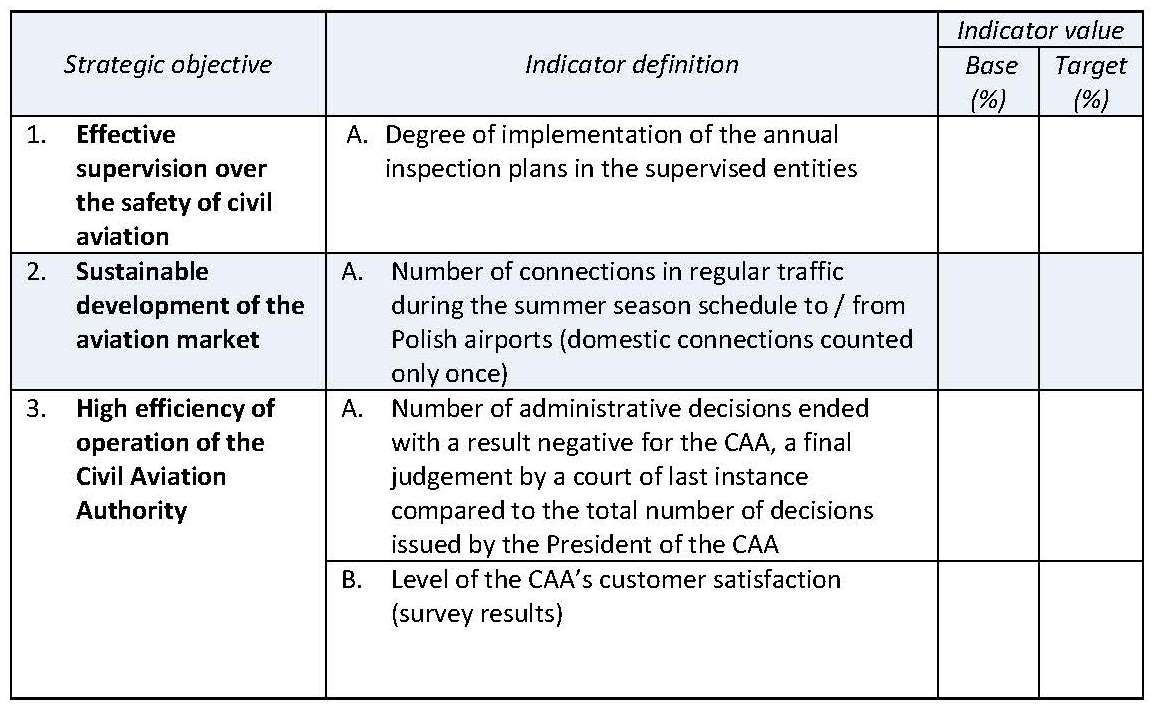Mission of the Civil Aviation Authority
Values of the Civil Aviation Authority
- Professionalism
- Efficiency
- Transparency
- Customer Focus
- Team Work
Objectives of the Strategic Plan
Strategic objective 1: Effective supervision over the safety of civil aviation
Operational objectives:
1.1. Compliance by the aviation market entities with safety requirements (including environmental protection) relevant for the type and scale of operations.
1.2. National Civil Aviation Safety Programme in place.
1.3. High level of safety culture in civil aviation.
1.4. Effective and rapid response to safety threats in civil aviation.
1.5. Improvement of the effectiveness of supervision over the safety of civil aviation.
1.6. Full standardisation of supervision over the compliance with regulations and standards (two level-standardisation: ICAO and EASA and the internal, national standardisation).
1.7. Active participation in international organisations and civil aviation agencies that is consistent with the interest of Poland.
Strategic objective 2: Sustainable development of the aviation market
Operational objectives:
2.1. Provision of competitive conditions for the participation of Polish aviation market entities in international agreements.
2.2. Access to aviation infrastructure for all users on equal and economically reasonable terms.
2.3. Limitation ofinadequate requirements for aviation entities.
2.4. Protection of the rights of passengers.
Strategic Objective 3: High efficiency of operation of the Civil Aviation Authority
Operational objectives:
3.1. High quality of services and efficient internal processes at the CAA.
3.2. High level of competence of the CAA employees.
3.3. High quality of legislative activity of the CAA.
3.4. Effective tools of the Integrated Management System
3.5. Positive image of the CAA.
3.6. Motivating work environment
Strategic Plan Management
Strategic Plan Management is carried out in the manner described in the following paragraphs:
1) The CAA’s Management Board is responsible for achieving the objectives of the CAA’s 2015 - 2019 Strategic Plan.
2) The General Director of the Civil Aviation Authority is responsible for ongoing coordination of the Strategic Plan implementation.
3) Implementation of the Strategic Plan is based on the task implementation packages for the organisational units.
4) Implementation of the Strategic Plan undergoes systematic monitoring in the management control system.
5) Monitoring is conducted on the basis of synthetic indicators presented on the next page of the document.
6) Monitoring results are the basis for periodic verification of the Strategic Plan.
7) The decision on the verification of the Strategic Plan is made by the President of the CAA.
8) Implementation of the strategic objectives will be reflected in the annual report on the operation of the CAA.
9) If events of particular importance for the ability to implement the Strategic Plan occur, the CAA’s Management Board analyses them immediately upon being informed about them.
10) If circumstances that threaten the implementation of the Strategic Plan occur, the CAA’s Management Board convenes an ad-hoc meeting of the directors of organisational units, conducts assessment of the situation and formulates proposals for the necessary changes in the plan.
The CAA’s Management Board introduces changes to the Strategic Plan on the basis of the conclusions reached by the directors of organisational units
Strategic objectives indicators form - template

CAA’s 2015-2019 Strategic Plan and Transport Development Strategy until 2020 (with 2030 perspective)
CAA’s 2015-2019 Strategic Plan refers to the Transport Development Strategy until 2020 (with 2030 perspective) adopted on 22 January 2013 (TDS).
As part of specific objective 1: to create a modern and coherent transport infrastructure network, one of the directions of intervention is to provide an environmentally sustainable development of the Polish aviation market. Sustainable development of the aviation market has been included in Strategic Plan No. 2. In turn, the environmental aspect has been included in Operational Objective 1.1. Compliance by the aviation market entities with safety requirements (including environmental protection) that are relevant to the type and scale of operations assigned to strategic objective 1: effective supervision over the safety of civil aviation.
Within specific objective 3 of TDS: improving the safety of air traffic users and transported goods, the following has been indicated as the direction of intervention in the field of air transport: introducing a system based on risk management - anticipating potential threats to civil aviation security and implementing the solutions that will be beneficial to the entire system, and not only to its selected elements. Aviation Safety has been included in Strategic Objective No. 1.
TDS Subsection 5.1.2., organisation and management of other transport sectors, indicated that the improvement of aviation transport management should include, e.g. monitoring of the air transport market functioning, in particular in terms of compliance with the principles of fair competition by carriers, and ensuring the safety and quality of services provided. This provision corresponds to strategic objective 1: effective supervision over the safety of civil aviation and 2: sustainable development of the aviation market
TDS Subsection 6.3., Aviation safety entirely corresponds with strategic objective 1: effective supervision over the safety of civil aviation and the following operational objectives assigned to it.
1.1. Compliance by the aviation market entities with safety requirements (including environmental protection) relevant for the type and scale of operations.
1.2. National Civil Aviation Security Programme in place.
1.3. High level of security culture in civil aviation.
1.4. Effective and rapid response to security threats in civil aviation.
1.5. Improvement of the effectiveness of supervision over the safety of civil aviation.
1.6. Full standardisation of supervision over the compliance with regulations and standards (two level-standardisation: ICAO and EASA and the internal, national standardisation).
Active participation in international organisations and civil aviation agencies that is consistent with the interest of Poland.

